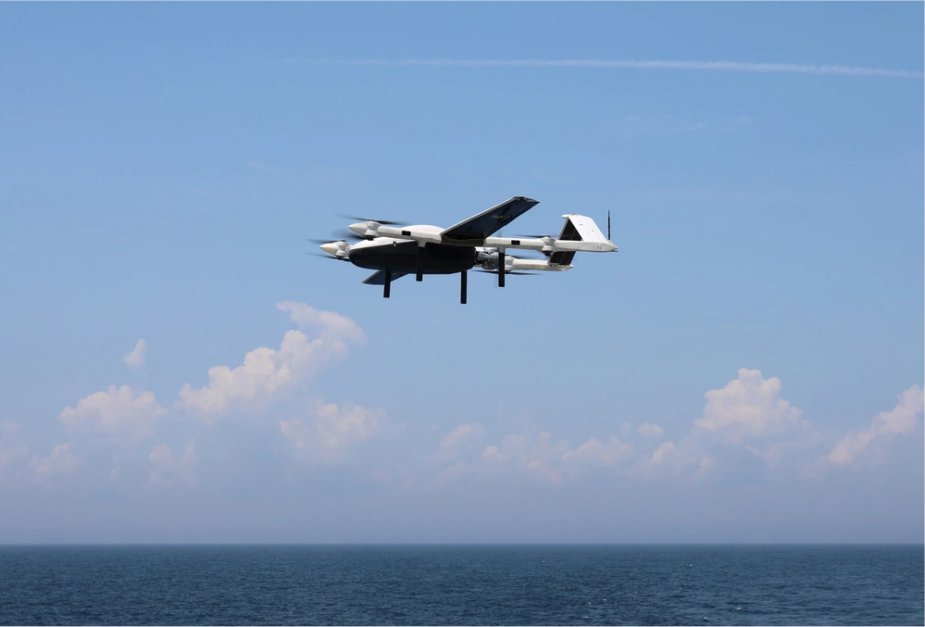Breaking news
US Navy will use Unmanned Aircraft Systems to resupply cargo.
According to information published by Naval Air Systems on November 9, 2021, the Navy and Marine Corps may soon have a way to resupply warfighters on the front line using unmanned systems capable of delivering necessary supplies from a distance in a variety of scenarios.
Follow Navy Recognition on Google News at this link
 Blue Water logistics UAS (Picture source: U.S. Department of Defense)
Blue Water logistics UAS (Picture source: U.S. Department of Defense)
The Department is considering several cargo resupply systems and recently demonstrated these capabilities to senior leadership during an event on Oct. 27 at NAWCAD’s Webster Outlying Field.
The Navy and Marine Corps Small Tactical Unmanned Aircraft Systems program office (PMA-263) and Naval Air Warfare Center Aircraft Division coordinated this event where operators from Air Test and Evaluation Squadron Two Four (UX-24) performed multiple resupply missions. The event was a two-part demonstration flying both the Tactical Resupply Unmanned Aircraft System (TRV-150) and Blue Water logistics UAS (BWUAS).
TRUAS is a Marine-focused platform for tactical resupply primarily onshore. It has a shorter range than Blue Water, but a heavier lift around 150 pounds. It’s intended to transport items like food and tactical gear to Marines in the field. Blue Water is a Navy-focused platform for resupply at sea. It has a longer range, and a smaller footprint to better fit onto ships. Its cargo capacity is smaller than TRUAS at 30-50 pounds.
Ervin’s team demonstrated the capabilities of land and airdrop using the TRV-150 and different payloads. For the first mission, they did an airdrop, where the system flew to a pre-programmed point, dropped the payload and flew back. During the second leg, the TRV-150 flew to specified coordinates, landed and released the payload. The operator on the ground retrieved the package and once it was safely out of the way, the operator pressed a button to return the UAS to its location.
Operators then flew BWUAS to demonstrate a vertical takeoff, transition to forward flight, and then back to VTOL for an airdrop. The system then transitioned back to forward flight and returned with a vertical landing.
Both the TRUAS and BWUAS teams are working closely with their Marine Corps and Military Sealift Command counterparts to rapidly bring these systems to the warfighter through innovative, non-traditional acquisition strategies. Both teams directly engaged with fleet users to understand what capability they need, and how they will use the capability in operation.
PMA-263, in collaboration with NAVAIR’s AirWorks, IMPAX, WOLF, and other contracting teams, used Other Transaction Authorities (OTAs) to quickly execute TRUAS. OTAs give the program the ability to make ongoing changes to the prototype based on the users’ input significantly reducing development time compared to a traditional acquisition program. The TRV-150 will be delivered to Marines as part of an extended user assessment in summer 2022.
NAWCAD is also using OTAs to prototype BWUAS technology and demonstrate the feasibility of autonomous tactical resupply at sea. Future system development will include improvements to the artificial intelligence and machine learning technology required for autonomous ship-based recovery, folding wings for improved wind and deck handling, and in-flight battery charging.
The Naval Air Warfare Center Aircraft Division (NAWCAD) conducts research, development, test, evaluation, and sustainment for all United States Navy and the United States Marine Corps aircraft and aircraft systems. It operates a test wing and ranges, facilities, laboratories, and aircraft in support of military operations worldwide.



























